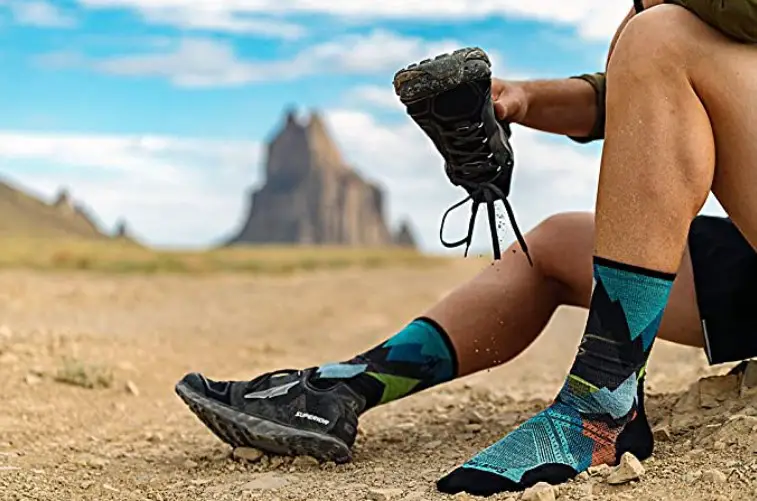Winter comes to mind when people think about wool socks. But did you know that wearing wool socks in the summer is equally beneficial?
Yes, we know that cotton is light and airy and it feels just the right choice for winter, yet it absorbs moisture and keeps it close to your skin, making it unsuitable for hot weather.
When you’re out on those long summer walks and runs, wool actually keeps your feet cool and dry. You’ll be more comfortable in a lighter wool ideal for summers, which wicks moisture away from the skin and keeps you cooler and dryer in any environment where perspiration is a possibility.

Wool socks, especially merino wool socks not only keeps your feet cool in the summer, but it also doesn’t wilt or wrinkle like cotton or linen in hot, humid conditions.
So what makes woollen socks, specifically merino wool socks ideal for summers?
1.) Because they’re super comfy and soft
We’re all aware of the benefits of wearing wool in summers. And merino woollen socks are no different.
Infact, what makes them unique is that merino wool fibres are finer and thinner than normal wool, whereas itching is a common complaint among people who wear regular wool socks.
You must wear anything below with regular wool to protect your skin from feeling uncomfortable but, because merino wool is so soft, you can straight away wear it on your skin.
See also: Best Work Boots for Summer
2.) They’re lightweight
Merino wool fibres are thinner and thus lighter than normal wool fibres. This improves the overall comfort of wearing the socks as we understand your feet will already be carrying the weight of your footwear, you don’t need the burden and discomfort of heavy socks.
3.) They have moisture wicking qualities
It’s actually beneficial to wear a non-cotton, moisture-wicking sock when doing any physical activity. If your sock does not wick perspiration away from your foot, it may cause irritation and possibly blisters, because wet feet in addition to friction is equal to painful blisters.
Therefore, you need merino wool, which is a moisture-wicking and breathable fabric that keeps your feet dry at all times. Also, because the fibres of this fabric are porous, it dries quickly.
4.) They keep the foul odor away
Summer days and sweaty feet might result in some really unpleasant odors. That is why merino wool socks are ideal for you as they are odor-resistant.
Merino socks are also antimicrobial, which means they fight bacteria that cause unpleasant odors and keep fungal infections away.
As a result, you can wear the same pair of socks for several days before washing them. And it’s for this reason that they’re perfect for outdoor adventures.
5.) It’s suitable for summers as well as for winters
Trust us when we say that your merino wool socks are all round in nature. Yes, it has temperature regulating features which means when it’s freezing cold outside, it keeps your feet warm, and when the temperature is hot, it keeps your feet cool.
I know it is truly incredible. The socks immediately transfer sweat away from the skin in the summer, keeping the foot cool and dry.
6.) They will last you a very long time
Yes, merino wool socks are quite durable. Infact, they are 5 or 6 times more durable than cotton socks, which means you don’t have to replace them frequently. The fabric’s fibre can be bent over many times.
Despite its lightweight, it can withstand temperatures as low as -50°F during the winters, and can keep you cool on a hot, humid day with temperatures as high as +86°F
Disadvantages of Woolen Socks
1.) It is durable but loses its structure over time
Merino wool socks have a high level of durability. It is actually more durable than typical wool socks.
However, after a certain number of uses and washes, the socks tend to lose their form and become loose. It isn’t necessarily a negative thing, but it isn’t ideal when you consider how costly it is.
Moths prefer merino wool because of its resilience. Moths are attracted to animal fibres as a source of food. Because merino wool is created from merino sheep, you’ll almost certainly have to defend your items from moths who want to eat them.
2.) It isn’t as soft
Merino wool socks definitely don’t feel like silk, but they’re not as scratchy or itchy as regular wool too.
3.) Retains moisture for long
Merino wool fibres are hydrophilic in nature, which means it has a difficult time releasing any moisture it has absorbed.
It can carry up to 35% of its weight in water without feeling wet, but that doesn’t mean it won’t feel heavy. When wet, merino wool does feel heavy.
4.) It’s costlier than other socks
Merino wool socks will no doubt cost you more than normal cotton or linen socks. While socks made of cotton will cost you 12$ for a set of 5, merino wool socks will cost around 24$ for 3-4 sets of socks.
5.) Maintenance is crucial
If not washed and cleaned properly, merino socks are prone to drinking and damage. When it comes to washing merino wool, there are a few rules to follow, like washing it on a mild cycle, avoiding the dryer, and limiting how often you wash it.
Although proper washing and drying can extend the life of your merino wool socks, you have to keep in mind that you have to dry the socks properly else the socks may shrink.
Here is a step by step method on how to wash and care for your merino wool socks:
1.) Turn the socks inside out before putting it in the washer as woollen socks are prone to pilling.
2.) Wash on the gentle cycle in warm or cold water. You should never use hot water since it might weaken fabric fibres and fade colours. You can also use the knit or wool cycle if your machine has one.
3.) When cleaning your socks, look for a mild detergent with a neutral ph range and no acids or alkalis, as these might weaken the fibres. Don’t use bleach, and don’t use fabric softener either.
You can go for Nikwax Tech Wash-
- Safely cleans technical synthetic outerwear without damaging DWR like normal household detergents
- Enhances performance of Nikwax waterproofing treatments; for use before TX.Direct, Cotton Proof, Polar Proof, and Softshell Proof
- Easy wash-in application; machine wash safe
- Recommended for technical clothing, synthetic sleeping bags, rain and ski jackets, GORE-TEX, Patagonia, North face, Columbia, and arcteryx
Prices pulled from the Amazon Product Advertising API on:
Product prices and availability are accurate as of the date/time indicated and are subject to change. Any price and availability information displayed on [relevant Amazon Site(s), as applicable] at the time of purchase will apply to the purchase of this product.
Make sure to air dry your merino wool socks, as heat wears down the quality of the socks.
Comparison between wool socks, cotton and synthetic socks in summers
Wool socks
Moisture wicking: Wool wicks moisture away from the body. They don’t get wet, are great at regulating temperature, and are surprisingly comfy.
Durability: Woolen socks are far more durable than cotton socks. Because the fabric is thicker, wearing them out takes a lot more uses and strain.
Breathability: Woollen socks are extremely breathable due to the porous structure of the fabric.
Odor control: Woollen socks absorb moisture because they can absorb significant amounts of water vapour – twice as much as cotton and thirty times as much as polyester – keeping the skin dry and preventing sweat, bacteria, and unpleasant odors from forming.
Cost: Wool socks, especially merino wool socks can be a bit pricier.
Cotton socks
Moisture wicking: Cotton retains moisture and takes a long time to dry, which is why cotton socks should be avoided. Cotton socks absorb moisture quickly, causing them to bunch up within the boots and rub against your skin causing blisters.
Durability: Cotton socks aren’t extremely long-lasting. Over time, the material gets thinner and develops tears.
Breathability: Cotton socks are recognised for being extremely breathable. Cotton is a permeable substance, thus it allows your feet to breathe.
Odor control: While cotton socks are popular, they’re not the ideal choice for preventing foot sweat or odor.
Cost: Cotton socks are not as expensive as merino wool socks.
Synthetic socks
Moisture wicking: Synthetic fabrics, such as Nylon and Lycra, can give a snug fit and arch support while also keeping your feet dry by absorbing sweat.
Durability: Synthetic socks made of nylon are extremely durable since they can be thin and smooth or thick and stretchy. Nylon is frequently blended with other fibres to enhance stretch or improve durability.
Breathability: Polyester-based synthetic socks are substantially more breathable than nylon-based synthetic socks.
Odor control: While cotton socks are popular, they’re not the ideal choice for preventing foot sweat or odor.
Cost: Socks made of synthetic fabrics are more affordable than merino wool or pure cotton socks.
Recommended wool socks for summer
Merino wool is usually mentioned among the best wool socks for summer because of all its wonderful properties. Let’s look at some best wool socks for summer:
1.) Darn Tough Midweight Sock
Darn Tough is a well-known hiking sock brand, and this pair lives up to its reputation. These cushioned socks include a blend of merino wool, nylon, and spandex for a soft fit that almost makes you forget you’re wearing them.
These socks are quite long-lasting; in fact, many reviewers stated that theirs haven’t worn out despite years of use.
- True Seamless technology allows for an undetectable seam fusion for an Ultra-smooth, invisible feel.
- Micro Crew Height - A shorter, more concise take on the traditional crew height. Peeks just above the top of a standard hiking boot.
- Composition - Knit with 59% Merino Wool, 39% Nylon, 2% Lycra Spandex
- Made in the USA
Prices pulled from the Amazon Product Advertising API on:
Product prices and availability are accurate as of the date/time indicated and are subject to change. Any price and availability information displayed on [relevant Amazon Site(s), as applicable] at the time of purchase will apply to the purchase of this product.
2.) Woolly Clothing Merino Wool Everyday Sock
These two sets of socks will quickly become your new favorites since they simply get the job done on all fronts. They’re made of a blend of merino wool, nylon, and spandex for comfort and durability, and they have moisture-wicking and anti-odor features.
- LIGHT WEIGHT MERINO WOOL CREW SOCKS
- CLASSIC FOUNDATIONAL STYLE FOR MAXIMUM VERSATILITY
- Enjoy the anti-odor, fire resistant, moisture wicking, and long wearing comfort of merino in every aspect of your life.
Prices pulled from the Amazon Product Advertising API on:
Product prices and availability are accurate as of the date/time indicated and are subject to change. Any price and availability information displayed on [relevant Amazon Site(s), as applicable] at the time of purchase will apply to the purchase of this product.
3.) Smartwool Phd Outdoor Socks
These socks are lighter than standard running socks, making them an excellent choice for hot temperatures.
They help minimise impact on the ball and heel of the foot by providing more cushioning on pressure spots.
They also have a snug fit, which helps to keep them from slipping and causing blisters. The socks are odor-resistant and sweat-absorbing, thanks to a blend of merino wool and nylon.
- Material: 63% merino wool, 35% nylon, 2% elastane
- Height: 8.5 in crew
- Weight: midweight
- Cushion: medium
- Recommended Use: hiking & camping
Prices pulled from the Amazon Product Advertising API on:
Product prices and availability are accurate as of the date/time indicated and are subject to change. Any price and availability information displayed on [relevant Amazon Site(s), as applicable] at the time of purchase will apply to the purchase of this product.
Conclusion
While we usually don’t pay much heed to the type of socks we purchase, we have to understand that we need to take the health of our feet seriously.
If your feet are happy, it will take you a long way but if they are uncomfortable, even a small step will become difficult.
Merino wool socks have all the qualities that are important for the health and hygiene of your feet. But before you go out to purchase, make sure to read the labels for a better understanding.
Rest, we have tried to include all that we could about woollen socks in this article. Hope it helps!












